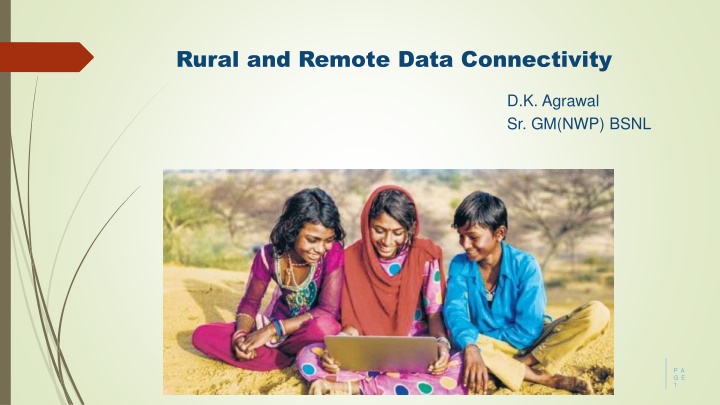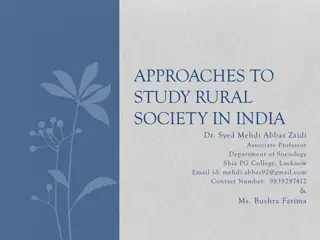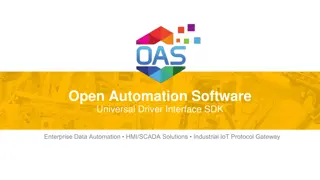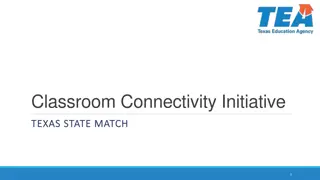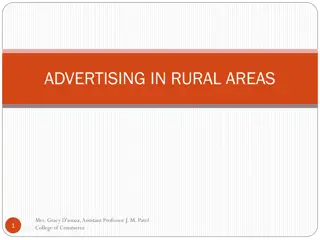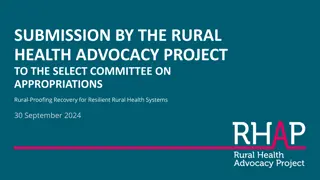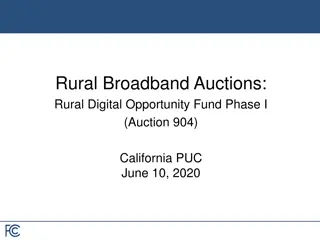Insights into Rural and Remote Data Connectivity in India
This collection of images and information provides an insightful overview of rural and remote data connectivity in India. It covers aspects such as rural population statistics, telecom connectivity parameters, village and Gram Panchayat connectivity status, challenges faced in connecting rural India, and requirements for enhancing rural data access. The data highlights the opportunities and limitations in bridging the digital divide and expanding connectivity to remote areas.
Download Presentation

Please find below an Image/Link to download the presentation.
The content on the website is provided AS IS for your information and personal use only. It may not be sold, licensed, or shared on other websites without obtaining consent from the author.If you encounter any issues during the download, it is possible that the publisher has removed the file from their server.
You are allowed to download the files provided on this website for personal or commercial use, subject to the condition that they are used lawfully. All files are the property of their respective owners.
The content on the website is provided AS IS for your information and personal use only. It may not be sold, licensed, or shared on other websites without obtaining consent from the author.
E N D
Presentation Transcript
Rural and Remote Data Connectivity D.K. Agrawal Sr. GM(NWP) BSNL P A G E 1
World vs India Rural Population 7.8 Bn, Urban; 4.37 Bn (56.2%) Rural; 3.43 Bn (43.8%) 1.33 Bn, Urban; 458 Mn (36.7%) Rural; 871 Mn (65.3%) P A G E 2
India in terms of Telecom connectivity Parameter Number of Subscribers Total 1,177.97 Million Urban 656.46 Million Rural 521.51 Million Rural Population Tele Density Internet / Data Subscribers 34.47 % 142.31 457.23 Million 65.53% 59.79 285.97 Million 87.37 720.78 Mn Internet Subscribers per 100 population 55.12 99.12 32.24 Economy on National Income 100 % 54% 46% Literacy 74.04 % 84.1 % 67.8 % P A G E 3
How Far we have Reached ? Number of Village in India 649,481 Number of Gram Panchayat : 250,000 Number of GPs with connected on Bharatnet :145,545 Number of GP , Wi-Fi Available 80,000 Plan to connect all village in next 1000 days wef 15.8.2020 Average Wireless Data Usage per wireless data subscriber per month 11 GB Average revenue realization per subscriber per GB Rs 11.23 P A G E 4
Rural/Remote Data Connectivity Limitations Populations in small clusters with vast open areas in between Low Income Low Affordability Difficult Terrain High Capital Expenditure Relatively Smaller Population Density Unreliable Grid Power Availability P A G E 5
Challenges in Connecting Rural India Low Average Revenue Per User (ARPU) - Affordability Unavailability of reliable high speed Backhaul Unreliable Availability of Grid Power P A G E 6
Rural Data Requirements Low Cost Solutions Low Device Costs Simpler Hardware and RF Design reducing the device costs Make in India Low cost Connectivity / backhaul solutions Using wireless backhaul/ middle mile in complementation of fiber Lower spectrum cost Using network sharing options to share spectrum across Radio Access More license-exempt spectrum (2.4Ghz, 5Ghz, 6Ghz, 60Ghz) Limited mobility support Mobility is required but not at very high speed Fixed/ Nomadic primary broadband access is the key P A G E 7
contd Rural data Requirements contd Energy efficient solutions Lowering system energy consumption Support for operation in power saving mode Enable working off non-conventional energy sources Large coverage area support Support for large cells to reduce CAPEX and OPEX Making use of existing telco infrastructure- ( Towers, Power, Backhaul) Less stringent need-based requirements Value Innovation Increase demand in the era of Covid19 Tele Education, Tele Medicine, Banking and financing, Agriculture Logistics , Animal Husbandry Smart Electric Meter (NSGM) P A G E 8
Rural Connectivity thinking in 3GPP Models a high-speed vehicle passing through non-urban areas, Driverless Vehicles & Critical Surgeries by Robots - Very futuristic and away from ground reality of rural and remote areas of India. Engrossed in solving the future problem of urban connectivity and ignoring the immediate problem of rural Connectivity. Do Doe es s n no ot t critically critically look at the look at the ground reality ground reality of of Ru Rura ral India (Bharat) l India (Bharat) P A G E 9
Key Features of Rural Data Network Large Coverage Area Cells to provide ubiquitous connectivity (LMLC) Small Cells (Wi-Fi Hotspots) as Access Points for High Speed Data Connectivity Wi-Fi devices are very low-cost and all pervasive Cloud based Architecture- Virtualised Core and Secured Control Separate Control and Data Plane Mirrors the Population Distribution & Scalable P A G E 1 0
Why WiFi (JanWi-Fi : NDCP Vision of creating 2 Mn Rural Wi-Fi Hotspots ) 1. Ubiquitous Each smart device (including Mobile Phones) is Wi-Fi enabled. 2. Uses unlicensed spectrum (ISM Band) which is free (690 MHz in 2.4GHz and 5GHz Band). 3. All IP Technology which is very efficient and future proof which is based on open and ever evolving standards of IEEE (802.11x). 4. Plug-n-Play ecosystem. 5. Low Power consuming and Low Cost overall infra cost about 15% of licensed mobile infrastructure. 6. Potential to conserve scarce licensed spectrum through Mobile Data Offload (MDO), Fixed Mobile Convergence (FMC). 7. NINENP (Non- Interfering, Non-Exclusive, Non-Protected) Free for All. 8. Current Hotspots in India 4.75 Lakhs (mushrooming everywhere). 9. Potential to deliver 4G and 5G type services through upgradation (802.11ac - Wave2,802.11ax Wi-Fi 6,Wi-Fi 6E) 10.Ideal futuristic platform for IoT, M2M and E-health, E-farming, E-education. 11.Wi-Fi to become a part of the 5G ecosystem through Release 16 & 17 of 3GPP IMT Standardisation process. P A G E 1 1
Legacy Operators Version Need of continuity of 2G services as the coverage is very large compare to 3G and 4G , and incumbent telecom operators evolved their network from 2G, less bandwidth requirement suitable for Satellite use Develop and rollout the IoT / M2M network in Rural Network Close alignment between the PSU Utilities Power and Telecoms ensuring the success for each other s programs Best in Class Technology for IoT Metering Devices: NB2 with fall-back to 2G Large Module Providers already ready with NB2 with 2G fall-back Legacy 2G Network with NB-IoT expansion will provide the best in class service at the most frugal rates Ready with QoSim [eSIM] with Remote Provisioning providing access to alternate networks ensuring best coverage and QoS for customers P A G E 1 2
P A G E 1 3
